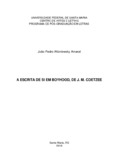| dc.creator | Amaral, João Pedro Wizniewsky | |
| dc.date.accessioned | 2017-11-27T13:45:36Z | |
| dc.date.available | 2017-11-27T13:45:36Z | |
| dc.date.issued | 2016-12-15 | |
| dc.identifier.uri | http://repositorio.ufsm.br/handle/1/12077 | |
| dc.description.abstract | Boyhood (1997) is the first volume of Scenes from Provincial Life trilogy, written by the South-African J. M. Coetzee. Boyhood’s narrative has peculiar characteristics for an autobiographical novel, as the third person narrator and the use of Present Simple. This research’s hypothesis is that the protagonist, the boy John Coetzee, discovers himself and discovers himself within the apartheid regime; and this self-discovery is not done through the form of teaching or reporting from a conscious and rational narrative. The process of discovering himself within this regime occurs through its infantile conscience, puerile observations and the construction of the general protagonist’s perception. From this hypothesis, we discuss in this dissertation selfwritting narratives and traditional confessional narratives in literature, based on Coetzee’s theoretical studies, to later analyze some of the main features of the narrative in this novel to verify how non-religious confession techniques are present in Boyhood. Coetzee manipulates these confessional techniques avoiding the typical confessional narrative, present in authors like Augustine, J. J. Rousseau and Dostoevsky. In this study, we also observe that the narrative episodes are based on confession, a self-investigating method that highlights painful contents to be confessed. Among these contents, we noticed the feelings of guilt and shame are recurrent in most the protagonist’s experiences. Confessional narrative is a method that Coetzee uses to debug knowledge and to select themes presented in Boyhood, differently from traditional confessional narratives. | eng |
| dc.language | por | por |
| dc.publisher | Universidade Federal de Santa Maria | por |
| dc.rights | Attribution-NonCommercial-NoDerivatives 4.0 International | * |
| dc.rights.uri | http://creativecommons.org/licenses/by-nc-nd/4.0/ | * |
| dc.subject | Autoficção | por |
| dc.subject | Confissão | por |
| dc.subject | Boyhood | por |
| dc.subject | J. M. Coetzee | por |
| dc.subject | Selfwritting | eng |
| dc.subject | Confession | eng |
| dc.subject | Boyhood | eng |
| dc.title | A escrita de si em Boyhood, de J. M. Coetzee | por |
| dc.title.alternative | Selfwritting in Boyhood, by J. M. Coetzee | eng |
| dc.type | Dissertação | por |
| dc.description.resumo | Boyhood (1997) é o primeiro volume da trilogia autobiográfica Scenes from Provincial Life, do escritor sul-africano J. M. Coetzee. A narrativa de Boyhood tem características peculiares para um romance autobiográfico, como o narrador em terceira pessoa e o uso do tempo presente. A hipótese de pesquisa é que o protagonista, o menino John Coetzee, descobre-se e descobre-se no regime do apartheid, e essa autodescoberta não se dá pela forma de ensinamento ou de relato a partir de uma narrativa consciente e racional. O processo de descobrir-se dentro desse regime dá-se através de sua consciência infantil, de observações pueris e da construção da percepção geral do protagonista. A partir dessa hipótese, discutimos nessa dissertação narrativas da escrita do eu e narrativas confessionais tradicionais na literatura, baseada em estudos teóricos de Coetzee, para, posteriormente, analisamos algumas das principais características da narrativa nessa obra para verificar como a técnicas de confissão não-religiosas estão presentes em Boyhood. Coetzee manipula essas técnicas evitando a típica narrativa confessional presente em autores como Agostinho, J. J. Rousseau e Dostoievski. Neste estudo, observamos também que os episódios da narrativa dão-se a partir da confissão, um método autoinvestigativo que traz à tona conteúdos dolorosos a serem confessados. Dentre esses conteúdos, também notamos que os sentimentos de culpa e de vergonha são recorrentes em boa parte dessas experiências do protagonista. A narrativa confessional é um método que Coetzee utiliza para depurar o conhecimento e selecionar os temas apresentados em Boyhood, diferente de narrativas confessionais tradicionais. | por |
| dc.contributor.advisor1 | Pereira, Lawrence Flores | |
| dc.contributor.advisor1Lattes | http://lattes.cnpq.br/2329033954605102 | por |
| dc.contributor.referee1 | Indrusiak, Elaine Barros | |
| dc.contributor.referee1Lattes | http://lattes.cnpq.br/6726224076135944 | por |
| dc.contributor.referee2 | Souto, Andrea do Roccio | |
| dc.contributor.referee2Lattes | http://lattes.cnpq.br/4763090579290391 | por |
| dc.creator.Lattes | http://lattes.cnpq.br/3273000573814597 | por |
| dc.publisher.country | Brasil | por |
| dc.publisher.department | Letras | por |
| dc.publisher.initials | UFSM | por |
| dc.publisher.program | Programa de Pós-Graduação em Letras | por |
| dc.subject.cnpq | CNPQ::LINGUISTICA, LETRAS E ARTES::LETRAS | por |
| dc.publisher.unidade | Centro de Artes e Letras | por |



